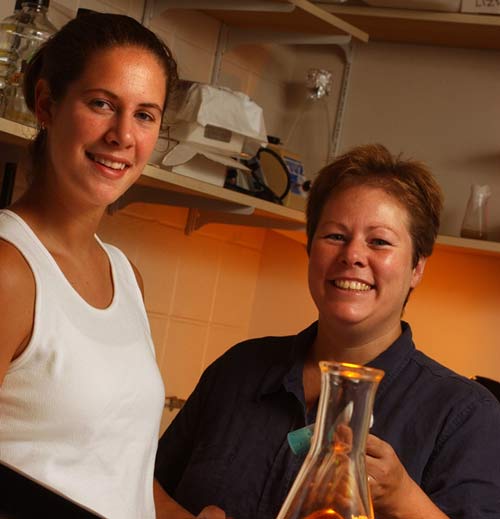When they’re deciding how to form into a body, cells talk to each other, and they make decisions they can’t go back on, says Elaine Reynolds, assistant professor of biology and chair of Lafayette’s neuroscience program.
“They decide to be skin, or muscle, or part of the nervous system, and then they make a further decision — to be this exact cell,” Reynolds says. Cells usually make the right choices, she says, allowing the organism to function as it’s supposed to and also act the way it should.
“In particular I want to understand the details of how living things work, the molecules and cells that give an animal its characteristics and its behavior,” Reynolds says.
She describes her teaching philosophy as “hierarchical,” that is, addressing multiple levels of complexity, from a molecule to a complete organism, to understand how the cells in the brain result in behavior.
That plays out both in her classroom teaching of neuroscience and also in her research, studying the relatively simple “model system” of the fruit fly in hopes of revealing the causes of epilepsy and other diseases in more complex creatures.
Reynolds, who joined the Lafayette faculty in 1997, has been working with fruit flies, including “bang-sensitive” mutants that go into paralysis when startled, for about 20 years, aiming to discover basics that will give people who work with higher organisms new research ideas. She holds a Ph.D. in biological sciences from Carnegie Mellon University and B.S. in microbiology from Penn State.
“Epilepsy is particularly intractable. There are so many causes in humans,” Reynolds says. “It’s the great unknown. So the idea is that going back to simpler systems may provide clues.”
Scientists can make and manipulate fruit fly mutations and then figure out what happened, helping to identify all the things that can cause the nervous system to seize or paralyze, she notes.
Reynolds’ work with fruit flies has created excellent opportunities for students to apply their knowledge from the classroom while learning lab techniques by doing experiments as EXCEL Scholars and through research courses.
Camille Marks ’99 [B.S. biochemistry] calls Reynolds “a wonderful teacher” and research adviser “who gives students the perfect amount of space to perform their research so they can feel a personal ownership of their work, yet never too much space that they feel off-track or unsure of themselves.”
Laura Feeney ’02[A.B. behavioral neuroscience], who is working toward a master’s in occupational therapy at Thomas Jefferson University in Philadelphia, says Reynolds’ focus on research design and analysis, rather than perfect results, contributes to students’ personal growth.
“She proves that a little ingenuity is more than sufficient to answer interesting biological questions,” says Nick Trotta ’00 [A.B. biology/English], who is pursuing his doctorate in biological sciences at Vanderbilt University. “In the process, she’s training good scientists who will go on to prolific careers.”
That’s one reason why Reynolds came to Lafayette, she says.
“I want to help prepare the next generation of great scientists to solve these problems. In some ways, that’s a bigger contribution than I could make as an individual researcher.”
Highlights
Publications: “Treatment with the antiepileptic drugs phenytoin and gabapentin ameliorates seizure and paralysis of Drosophila bang-sensitive mutants” (coauthors Eric Stauffer ’02 [B.S. neuroscience], LauraFeeney ’02 [B.S. behavioral neuroscience], Elizabeth Rojahn ’03 [A.B. biology], Benjamin Jacobs ’01 [A.B. biology], and Carol McKeever ’00 [A.B. biology]), Journal of Neurobiology (2003); “The Drosophila slamdance gene: a mutation in an aminopeptidase can cause seiszure, paralysis and neuronal failure (coauthors H. Zhang, J. Tan, D. Kueber, S. Faulhaber, and M. Tanouye), Genetics 162: 1283-1299 (2002); “Tissue-specific and developmental effects of the easily shocked mutation on ethanolamine kinase activity and phospholipid composition in Drosophila melanogaster” (coauthors Marian Nyako ’00 [B.S. biochemistry], Camille Marks ’99 [B.S. biochemistry], and Joseph Sherma, professor emeritus of chemistry), Biochemical Genetics 39(9-10): 339-349 (2001)
Honors: Lafayette’s Delta Upsilon Distinguished Mentoring and Teaching Award, 2002; National Science Foundation grant “Drosophila Bang-Sensitive Mutants as a Model for Mitrochondiral Function in the Nervous System,” principal investigator, August 2003-July 2006; National Science Foundation grant “Acquisition of the C1 Confocal Microscopy System for Cellular Analysis in the Biological Sciences,” co-principal investigator with Robert A. Kurt, assistant professor of biology, July 2002-July 2004
Accomplishments: Chair of neuroscience program. She has involved more than 30 students in her research program, including a dozen students who have coauthored papers that have been published or accepted for publication in scientific journals. She also has partnered with Lafayette students on more than 20 published abstracts and papers presented at conferences
Contact: (610) 330-5654; reynolde

A National Leader in Undergraduate Research. Elizabeth Rojahn ’03 coauthored an article with Elaine Reynolds, associate professor of biology and chair of neuroscience, in the Journal of Neurobiology.
